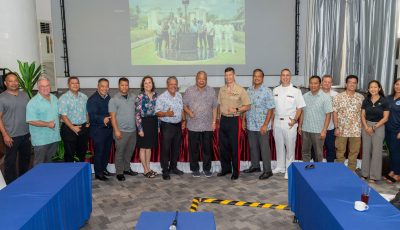Marines control the ‘Wild West of the Sky’
By LANCE CPL. TYLER NGIRASWEI
III Marine Expeditionary Force
WEST FIELD, TINIAN, Commonwealth of the Northern Mariana Islands—Dubbed as the “Wild West of the Sky” by some Forager Fury III Marines, the uncontrolled air space surrounding Tinian’s West field exists because it is the home of a public airport without an air control tower.
- Cpl. Michael D. Smith, from Thousand Oakes, California, checks on the generator and communicating gear for the remote landing site tower on Sept. 24 during the Forager Fury III exercise on Tinian’s West Field. The remote landing site tower is highly deployable and can fit onto the back of a Humvee, according to Smith. Smith is with air traffic control maintenance, Marine Air Control Squadron 4, Marine Air Control Group 18, 1st Marine Aircraft Wing, III Marine Expeditionary Force. U.S. MARINE CORPS /LANCE CPL. TYLER NGIRASWEI
- Cpl. Jared A. Simmons, from Spencer, Massachusetts, relays a message from a pilot to the ground troops on Sept. 24 during the Forager Fury III exercise on Tinian’s West Field. The air traffic control tower controls both military and commercial flights in Tinian’s air space and ensures their safety. Simmons is an air traffic controller with Marine Air Control Squadron 4, Marine Air Control Group 18, 1st Marine Aircraft Wing, III Marine Expeditionary Force. (U.S. MARINE CORPS /LANCE CPL. TYLER NGIRASWEI)
An estimated 1,300 personnel are participating in Forager Fury III, a Marine Corps-led exercise involving a full spectrum of fixed wing and rotary aircraft operations. It has a heavy emphasis on tactical aviation and aviation ground support to further develop expeditionary combat capabilities in the Marianas Island Range Complex. The exercise began Sept. 24, 2014, and is scheduled to last until Oct. 6.
Small airplanes are constantly using the runway on Tinian to bring passengers to Saipan and back with minimal guidance. Add that to the increased air traffic from Forager Fury III and you may expect a more white-knuckled environment.
To counter the potential danger, Marine Air Control Squadron 4, Marine Air Control Group 18, 1st Marine Aircraft Wing, III Marine Expeditionary Force has erected a remote landing site tower manned by Marine air traffic controllers on West Field.
“We provide advisories to make sure everybody in the air and on the ground are on the same page,” said 1st Lt. Jeremy Graves, Tinian’s air boss during the exercises and air traffic controller with MACS-4.
The communication between people in the air and on the ground is vital to safety, according to Graves, from Melbourne, Florida.
“Safety is paramount and having the air traffic controllers at our side with communication helps us see all the moving parts—the aircraft, vehicles and people,” said Gunnery Sgt. Charles Maddox, the expeditionary air fields staff noncommissioned officer with Marine Wing Support Squadron 171, Marine Aircraft Group 12, 1st MAW, III MEF. “It helps control the chaos because they are our second pair of eyes.”
Marine air traffic controllers are able to facilitate the incoming and outgoing aircraft to ensure the safety of both the civilian and military flights.
“We are the first step for safety because we are the only ones in direct communication with the pilots,” said Cpl. Eriberto Cura, an air traffic controller with MACS-4. “If we know what they are doing we can pass that information to those on the ground.”
The Marines on the ground have the air traffic controllers giving them a wider view of what is inbound, and the communication results in a safer environment, according to Maddox, from West Palm Beach, Florida.
Many lives are in the hands of the air traffic controllers, according to Cura, from West Palm Beach. He said he is confident their training allows them to manage the skies by providing a medium between the air and the ground.
“The safety of aircraft and personnel is our main objective,” said Cura. “As a controller, stress is something you are taught to handle no matter how much pressure you are under.”





























